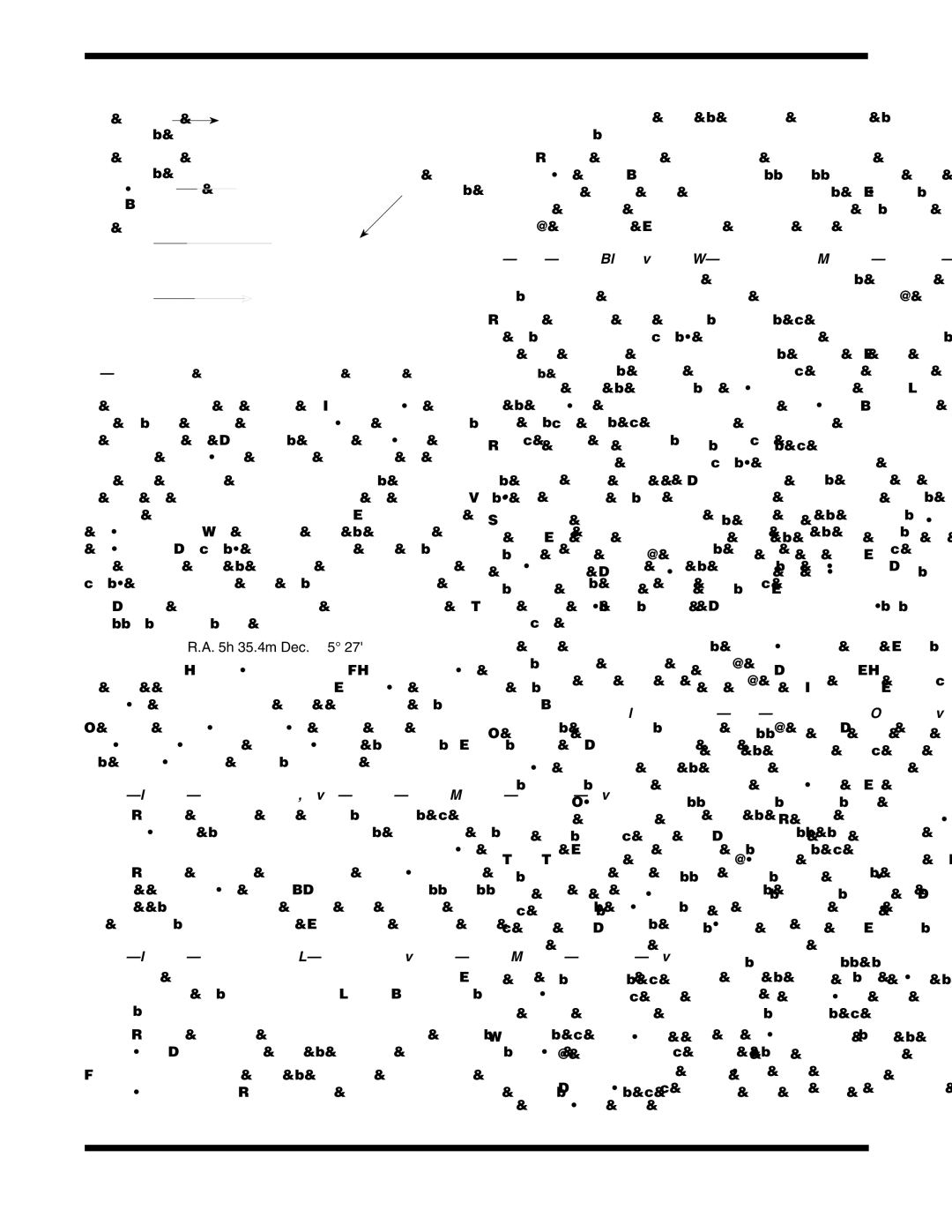Dec. setting circle
circle
Dec. setting | | | | R.A. |
circle | | | | setting |
thumbscrew | | | | circle |
|
(2) | | | | | | |
Dec. | | | | |
indicator | | | | | |
| | | | |
arrow | | | | |
R.A. | | | | |
indicator | | | | | |
| | | | |
arrow | | | | R.A. setting circle |
| | | | | | thumbscrew (2) |
Figure 11. The R.A. and Dec. setting circles.
ments (there are 60 minutes in 1 hour of right ascension). The lower set of numbers apply to viewing in the Northern Hemisphere, while the numbers above them apply to viewing in the Southern Hemisphere.
The Dec. setting circle is scaled in degrees, with each mark representing 2° increments. Values of declination coordinates range from +90° to -90°. The 0° mark indicates the celestial equator. When the telescope is pointed north of the celestial equator, values of the declination setting circle are positive; when the telescope is pointed south of the celestial equator, values of the declination setting circle are negative.
So, the coordinates for the Orion Nebula listed in a star atlas will look like this:
R.A. 5h 35.4m Dec. –5° 27'
That’s 5 hours and 35.4 minutes in right ascension, and -5 degrees and 27 arc-minutes in declination (there are 60 arc- minutes in 1 degree of declination).
Before you can use the setting circles to locate objects, the mount must be accurately polar aligned, and the setting cir- cles must be calibrated.
Calibrating the Declination Setting Circle
1.Loosen the Dec. lock lever and position the telescope as accurately as possible in declination so it is parallel to the R.A. axis as shown in Figure 1. Re-tighten the lock lever.
2.Loosen one of the thumbscrews on the Dec. setting circle (see Figure 11), this will allow the setting circle to rotate freely. Rotate the Dec. setting circle until the pointer reads exactly 90°. Re-tighten the setting circle thumbscrew.
Calibrating the Right Ascension Setting Circle
1.Identify a bright star in the sky near the celestial equa- tor (declination = 0°) and look up its coordinates in a star atlas.
2.Loosen the R.A. and Dec. lock levers on the equatorial mount, so the telescope optical tube can move freely.
3.Point the telescope at the bright star whose coordinates you know. Lock the R.A. and Dec. lock levers. Center the
star in the telescope’s field of view with the slow-motion control knobs.
4.Loosen one of the R.A. setting circle thumbscrews (see Figure 11); this will allow the setting circle to rotate freely. Rotate the setting circle until the R.A. pointer arrow indi- cates the R.A. coordinate listed in the star atlas for the object. Re-tighten the setting circle thumbscrew.
Finding Objects With the Setting Circles
Now that both setting circles are calibrated, look up in a star atlas the coordinates of an object you wish to view.
Loosen the Dec. lock lever and rotate the telescope until the declination value from the star atlas matches the reading on the Dec. setting circle. Remember that values of the Dec. set- ting circle are positive when the telescope is pointing north of the celestial equator (Dec. = 0°), and negative when the telescope is pointing south of the celestial equator. Retighten the lock lever.
Loosen the R.A. lock lever and rotate the telescope until the right ascension value from the star atlas matches the reading on the R.A. setting circle. Remember to use the lower set of numbers on the R.A. setting circle. Retighten the lock lever.
Most setting circles are not accurate enough to put an object dead-center in the telescope’s eyepiece, but they should place the object somewhere within the field of view of the find- er scope, assuming the equatorial mount is accurately polar aligned. Use the slow-motion controls to center the object in the finder scope, and it should appear in the telescope’s field of view.
The setting circles must be re-calibrated every time you wish to locate a new object. Do so by calibrating the setting circles for the centered object before moving on to the next one.
Confused About Pointing the Telescope?
Beginners occasionally experience some confusion about how to point the telescope overhead or in other directions. In Figure 1 the telescope is pointed north as it would be during polar alignment. The counterweight shaft is oriented down- ward. But it will not look like that when the telescope is pointed in other directions. Let’s say you want to view an object that is directly overhead, at the zenith. How do you do it?
DO NOT make any adjustment to the latitude adjustment L- bolts. That will spoil the mount’s polar alignment. Remember, once the mount is polar aligned, the telescope should be moved only on the R.A. and Dec. axes. To point the scope overhead, first loosen the R.A. lock lever and rotate the tele- scope on the right ascension axis until the counterweight shaft is horizontal (parallel to the ground). Then loosen the Dec. lock lever and rotate the telescope until it is pointing straight overhead. The counterweight shaft is still horizontal. Then retighten both lock levers.
What if you need to aim the telescope directly north, but at an object that is nearer to the horizon than Polaris? You can’t do it with the counterweights down as pictured in Figure 1. Again, you have to rotate the scope in right ascension so that the counterweight shaft is positioned horizontally. Then rotate

